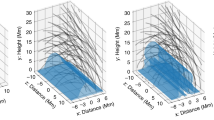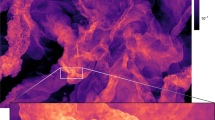Abstract
Solar filaments, also called solar prominences when appearing above the solar limb, are cold, dense materials suspended in the hot tenuous solar corona, consisting of numerous long, fibril-like threads. These threads are the key to disclosing the physics of solar filaments. Similar structures also exist in galaxy clusters. Besides their mysterious formation, filament threads are observed to move with alternating directions, which are called counterstreaming flows. However, the origin of these flows has not been clarified yet. Here we report that turbulent heating at the solar surface is the key, which randomly evaporates materials from the solar surface to the corona, naturally reproducing the formation and counterstreamings of the sparse threads in the solar corona. We further suggest that while the cold Hα counterstreamings are mainly due to longitudinal oscillations of the filament threads, there are million-kelvin counterstreamings in the corona between threads, which are alternating unidirectional flows.
This is a preview of subscription content, access via your institution
Access options
Access Nature and 54 other Nature Portfolio journals
Get Nature+, our best-value online-access subscription
$29.99 / 30 days
cancel any time
Subscribe to this journal
Receive 12 digital issues and online access to articles
$119.00 per year
only $9.92 per issue
Buy this article
- Purchase on Springer Link
- Instant access to full article PDF
Prices may be subject to local taxes which are calculated during checkout






Similar content being viewed by others
Data availability
Any snapshots of simulation data (2 TB in size) are available on request to Y.H.Z. (yuhaozhou1991@gmail.com). The data for the figures are avaliable at https://doi.org/10.6084/m9.figshare.11956482.
Code availability
The code we used is the open-source code AMRVAC 2.0, which can be downloaded directly from its website49.
References
Mackay, D. H., Karpen, J. T., Ballester, J. L., Schmieder, B. & Aulanier, G. Physics of solar prominences: II—Magnetic structure and dynamics. Space Sci. Rev. 151, 333–399 (2010).
Vial, J.-C. & Engvold, O. Solar Prominences Vol. 415 (Springer, 2015).
Chen, P. F. Coronal mass ejections: models and their observational basis. Living Rev. Sol. Phys. 8, 1 (2011).
Schmieder, B., Démoulin, P. & Aulanier, G. Solar filament eruptions and their physical role in triggering coronal mass ejections. Adv. Space Res. 51, 1967–1980 (2013).
Wang, Y.-M. The jetlike nature of He ii λ 304 prominences. Astrophys. J. Lett. 520, L71–L74 (1999).
Wang, J. et al. Formation and material supply of an active-region filament associated with newly emerging flux. Mon. Not. R. Astron. Soc. 488, 3794–3803 (2019).
Antiochos, S. K. & Klimchuk, J. A. A model for the formation of solar prominences. Astrophys. J. 378, 372–377 (1991).
Liu, W., Berger, T. E. & Low, B. C. First SDO/AIA observation of solar prominence formation following an eruption: magnetic dips and sustained condensation and drainage. Astrophys. J. Lett. 745, L21 (2012).
Lites, B. W. & Low, B. C. Flux emergence and prominences: a new scenario for 3-dimensional field geometry based on observations with the advanced stokes polarimeter. Sol. Phys. 174, 91–98 (1997).
Kaneko, T. & Yokoyama, T. Reconnection-condensation model for solar prominence formation. Astrophys. J. 845, 12 (2017).
Li, L. et al. Repeated coronal condensations caused by magnetic reconnection between solar coronal loops. Astrophys. J. 884, 34 (2019).
Dunn, R. B. Photometry of the Solar Chromosphere. PhD thesis, Harvard Univ. (1961).
Simon, G., Schmieder, B., Demoulin, P. & Poland, A. I. Dynamics of solar filaments. VI—Center-to-limb study of Hα and C iv velocities in a quiescent filament. Astron. Astrophys. 166, 319–325 (1986).
Heinzel, P. The fine structure of solar prominences. In Astronomical Society of the Pacific Conference Series Vol. 368 (eds. Heinzel, P. et al.) 271–290 (Astronomical Society of the Pacific, 2007).
Engvold, O. Observations of filament structure and dynamics (review). In IAU Colloquium 167: New Perspectives on Solar Prominences, Astronomical Society of the Pacific Conference Series Vol. 150 (eds Webb, D. F. et al.) 23–31 (Astronomical Society of the Pacific, 1998).
Lin, Y., Engvold, O., Rouppe van der Voort, L., Wiik, J. E. & Berger, T. E. Thin threads of solar filaments. Sol. Phys. 226, 239–254 (2005).
Hood, A. W., Priest, E. R. & Anzer, U. The fibril structure of prominences. Sol. Phys. 138, 331–351 (1992).
Zhou, Y.-H., Zhang, L.-Y., Ouyang, Y., Chen, P. F. & Fang, C. Solar filament longitudinal oscillations along a magnetic field tube with two dips. Astrophys. J. 839, 9 (2017).
Priest, E. R., Hood, A. W. & Anzer, U. The fibril structure of prominences. Sol. Phys. 132, 199–202 (1991).
van der Linden, R. A. M. Can fine-structure in prominences be due to perpendicular thermal conduction. Geophys. Astrophys. Fluid Dyn. 69, 183–199 (1993).
Hillier, A. S. On the nature of the magnetic Rayleigh–Taylor instability in astrophysical plasma: the case of uniform magnetic field strength. Mon. Not. R. Astron. Soc. 462, 2256–2265 (2016).
Xia, C. & Keppens, R. Formation and plasma circulation of solar prominences. Astrophys. J. 823, 22 (2016).
Heinzel, P. & Anzer, U. On the fine structure of solar filaments. Astrophys. J. Lett. 643, L65–L68 (2006).
Martin, S. F., Lin, Y. & Engvold, O. A method of resolving the 180-degree ambiguity by employing the chirality of solar features. Sol. Phys. 250, 31–51 (2008).
Schmieder, B. et al. Reconstruction of a helical prominence in 3D from IRIS spectra and images. Astron. Astrophys. 606, A30 (2017).
Schmieder, B., Raadu, M. A. & Wiik, J. E. Fine structure of solar filaments. II—Dynamics of threads and footpoints. Astron. Astrophys. 252, 353–365 (1991).
Zirker, J. B., Engvold, O. & Martin, S. F. Counter-streaming gas flows in solar prominences as evidence for vertical magnetic fields. Nature 396, 440–441 (1998).
Lin, Y., Engvold, O. R. & Wiik, J. E. Counterstreaming in a large polar crown filament. Sol. Phys. 216, 109–120 (2003).
Wang, H. et al. Extending counter-streaming motion from an active region filament to a sunspot light bridge. Astrophys. J. Lett. 852, L18 (2018).
Chen, P. F., Harra, L. K. & Fang, C. Imaging and spectroscopic observations of a filament channel and the implications for the nature of counter-streamings. Astrophys. J. 784, 50 (2014).
Ahn, K., Chae, J., Cao, W. & Goode, P. R. Patterns of flows in an intermediate prominence observed by hinode. Astrophys. J. 721, 74–79 (2010).
Zou, P. et al. Material supply and magnetic configuration of an active region filament. Astrophys. J. 831, 123 (2016).
Luna, M., Karpen, J. T. & DeVore, C. R. Formation and evolution of a multi-threaded solar prominence. Astrophys. J. 746, 30 (2012).
Kucera, T. A., Tovar, M. & de Pontieu, B. Prominence motions observed at high cadences in temperatures from 10 000 to 250 000 K. Sol. Phys. 212, 81–97 (2003).
Kucera, T. A., Gilbert, H. R. & Karpen, J. T. Mass flows in a prominence spine as observed in EUV. Astrophys. J. 790, 68 (2014).
Alexander, C. E. et al. Anti-parallel EUV flows observed along active region filament threads with Hi-C. Astrophys. J. Lett. 775, L32 (2013).
Diercke, A., Kuckein, C., Verma, M. & Denker, C. Counter-streaming flows in a giant quiet-sun filament observed in the extreme ultraviolet. Astron. Astrophys. 611, A64 (2018).
Heinzel, P., Gunár, S. & Anzer, U. Fast approximate radiative transfer method for visualizing the fine structure of prominences in the hydrogen Hα line. Astron. Astrophys. 579, A16 (2015).
Xia, C., Chen, P. F., Keppens, R. & van Marle, A. J. Formation of solar filaments by steady and nonsteady chromospheric heating. Astrophys. J. 737, 27 (2011).
Aulanier, G. & Schmieder, B. The magnetic nature of wide EUV filament channels and their role in the mass loading of CMEs. Astron. Astrophys. 386, 1106–1122 (2002).
Gunár, S., Dudík, J., Aulanier, G., Schmieder, B. & Heinzel, P. Importance of the Hα visibility and projection effects for the interpretation of prominence fine-structure observations. Astrophys. J. 867, 115 (2018).
Tu, J. & Song, P. A study of Alfvén wave propagation and heating the chromosphere. Astrophys. J. 777, 53 (2013).
Ouyang, Y., Zhou, Y. H., Chen, P. F. & Fang, C. Chirality and magnetic configurations of solar filaments. Astrophys. J. 835, 94 (2017).
Karpen, J. T., Antiochos, S. K., Hohensee, M., Klimchuk, J. A. & MacNeice, P. J. Are magnetic dips necessary for prominence formation? Astrophys. J. Lett. 553, L85–L88 (2001).
Withbroe, G. L. & Noyes, R. W. Mass and energy flow in the solar chromosphere and corona. Ann. Rev. Astron. Astrophys. 15, 363–387 (1977).
Aschwanden, M. J. An evaluation of coronal heating models for active regions based on Yohkoh, SOHO, and TRACE observations. Astrophys. J. 560, 1035–1044 (2001).
Xia, C., Chen, P. F. & Keppens, R. Simulations of prominence formation in the magnetized solar corona by chromospheric heating. Astrophys. J. Lett. 748, L26 (2012).
Keppens, R. & Xia, C. The dynamics of funnel prominences. Astrophys. J. 789, 22 (2014).
Xia, C., Teunissen, J., ElMellah, I., Chané, E. & Keppens, R. MPI-AMRVAC 2.0 for solar and astrophysical applications. Astrophys. J. Suppl. Ser. 234, 30 (2018).
Harten, A., Lax, P. D. & Leer, Bv On upstream differencing and Godunov-type schemes for hyperbolic conservation laws. SIAM Rev. 25, 35–61 (1983).
Čada, M. & Torrilhon, M. Compact third-order limiter functions for finite volume methods. J. Comput. Phys. 228, 4118–4145 (2009).
Colgan, J. et al. Radiative losses of solar coronal plasmas. Astrophys. J. 689, 585–592 (2008).
Antiochos, S. K., MacNeice, P. J. & Spicer, D. S. The thermal nonequilibrium of prominences. Astrophys. J. 536, 494–499 (2000).
Schure, K. M., Kosenko, D., Kaastra, J. S., Keppens, R. & Vink, J. A new radiative cooling curve based on an up-to-date plasma emission code. Astron. Astrophys. 508, 751–757 (2009).
Townsend, R. H. D. An exact integration scheme for radiative cooling in hydrodynamical simulations. Astrophys. J. Suppl. Ser. 181, 391–397 (2009).
Withbroe, G. L. The temperature structure, mass, and energy flow in the corona and inner solar wind. Astrophys. J. 325, 442–467 (1988).
Matsumoto, T. & Kitai, R. Temporal power spectra of the horizontal velocity of the solar photosphere. Astrophys. J. 716, L19–L22 (2010).
Anzer, U. & Heinzel, P. On the nature of dark extreme ultraviolet structures seen by SOHO/EIT and TRACE. Astrophys. J. 622, 714–721 (2005).
Dere, K. P., DelZanna, G., Young, P. R., Landi, E. & Sutherland, R. S. CHIANTI—an atomic database for emission lines. XV. Version 9, improvements for the X-ray satellite lines. Astrophys. J. Suppl. Ser. 241, 22 (2019).
Acknowledgements
We thank P. Heinzel, R. Keppens, T. Yokoyama, K. E. Yang and E. S. Liang for valuable suggestions, partly during the ISSI-BJ team meeting. P.F.C. was supported by the Chinese foundations (NSFC 11533005 and 11961131002) and Jiangsu 333 Project (BRA2017359). Y.H.Z. is supported by the Belgian FWO-NSFC project G0E9619N and the Program A for Outstanding PhD candidates in Nanjing University. The simulations were done on the computers in the High Performance Computing Centre of Nanjing University.
Author information
Authors and Affiliations
Contributions
Y.H.Z. performed the simulations and wrote the first draft. P.F.C. initiated the study, supervised the project and led the discussions. J.H. contributed to the calculation of the synthesized EUV image. C.F. contributed to discussions on the Hα calculation.
Corresponding author
Ethics declarations
Competing interests
The authors declare no competing interests.
Additional information
Publisher’s note Springer Nature remains neutral with regard to jurisdictional claims in published maps and institutional affiliations.
Rights and permissions
About this article
Cite this article
Zhou, Y.H., Chen, P.F., Hong, J. et al. Simulations of solar filament fine structures and their counterstreaming flows. Nat Astron 4, 994–1000 (2020). https://doi.org/10.1038/s41550-020-1094-3
Received:
Accepted:
Published:
Issue Date:
DOI: https://doi.org/10.1038/s41550-020-1094-3
This article is cited by
-
Resolving the solar prominence/filament paradox using the magnetic Rayleigh–Taylor instability
Nature Astronomy (2022)
-
Persistent fast kink magnetohydrodynamic waves detected in a quiescent prominence
Science China Physics, Mechanics & Astronomy (2022)
-
Multiwavelength Observations of a Partial Filament Eruption on 13 June 2011
Solar Physics (2022)
-
The Chinese Hα Solar Explorer (CHASE) mission: An overview
Science China Physics, Mechanics & Astronomy (2022)



